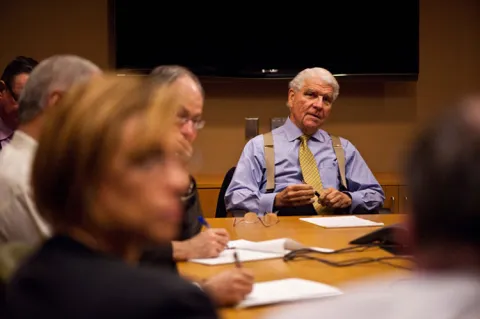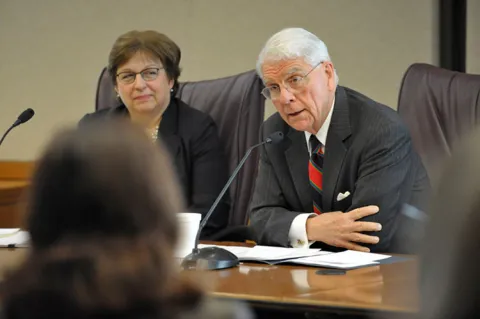As required by statute, the Director must publish an Annual Report of activities of the Administrative Office (AO) and submit it to the Judicial Conference and Congress. For the first time, this report is being prepared and transmitted electronically. The cost savings are not enormous, but the message—the Judiciary looks closely at how it spends its funds—is a crucial one and a clear reflection of our firm commitment to cost containment.

Judge Thomas Hogan meets with members of the AO legislative council.
Director's Message
It is a great honor to be the first judge to serve as Director of the Administrative Office since its creation 72 years ago. I appreciate the confidence and support of the Chief Justice, as well as the fine work that has been done by my predecessor and friend, Jim Duff.
In my 29 years as a trial judge, I have come to recognize the privilege of working for the Third Branch, as well as the many challenges we face. No doubt, these are difficult times and the AO must continue its leadership and support roles in helping the Judicial Branch maintain our tradition of excellence while preserving the principle of judicial independence that is so fundamental to our democracy.
While our fiscal year 2012 appropriation is a modest increase over the preceding year, it is a significant achievement in today's budgetary climate and a clear reflection that Congress made funding the Third Branch of government a priority. We all should be grateful for that support.
Nevertheless, for some time we have been warning of tightening budgets and limited resources. These harsh realities have arrived, and appear to be with us for a while. The cost-containment measures that have been implemented in recent years have played a significant role in helping us minimize the negative impact the funding constraints have on court operations. However, we must continue the momentum we have generated, and explore and develop new ways to manage our limited resources efficiently. Certainly that is the philosophy we have adopted at the AO. We, too, have an ongoing cost-containment effort in place and are assessing organizational, policy, and process improvements so that the AO can continue to reduce our costs.
Regardless of the level of funding, important court work must continue. Workloads at nearly every level are on the rise. The number of persons under supervision is 12 percent higher today than it was five years ago. Civil filings have risen 12 percent, and the number of criminal defendant filings has increased 17 percent since 2007. The courts are busy, as is the administrative apparatus that supports their work.
Judicial Conference committees are discussing important business that impacts court operations, and in consultation with the AO and court advisory groups, we are looking at ways to cut costs while continuing mission-critical work. The requirements gathering stage for the next generation of the Case Management/Electronic Case Files system is nearing completion, assisted greatly by thousands of comments from users inside and outside the Judiciary. The new system will be more streamlined, while offering greater standardization and efficiency for users.
The codes of conduct for judges and for court employees are among the resources used throughout the Judiciary to ensure that the Judiciary abides by the highest standards of integrity. Financial accountability is a core value of the Judiciary. The AO does its part by conducting court audits and program reviews and continuously looking for new accountability tools to provide courts. Nowhere is our partnership more effective than when AO and court staff work hand-in-hand to assure that taxpayer funds are spent responsibly.

Judge Thomas Hogan leads regular meetings with AO senior staff.
The AO is committed to strengthening IT security, expanding mobile computing and remote access, and exploring new ways to use technology to work smarter. We are assisting courts with their essential emergency preparedness and continuity of operations needs through advanced technology. Probation and pretrial services officers perform an important role in keeping communities safe, and have long been leaders in maximizing the latest technology to supervise offenders more effectively and less expensively. AO staff are working with these court offices, as well as judges' chambers, in continuing to develop more modern tools to meet their needs.
I am also pleased with the AO's efforts to provide greater public access to the courts through the use of enhanced technology. This past year, the public benefited from new features added to the PACER system, which provides electronic public access to more than 500 million court documents. The eJuror program, which is in use in most district courts, allows jurors to complete questionnaires and forms online, saving both time and money. The AO has developed a toolbox that courts are using to improve and standardize their Internet websites. The Judicial Conference's cameras in court pilot—which allows the public to view certain proceedings in their entirety over the Internet—was implemented in 2011 with valuable input from AO staff. Helping the public will always be an important AO function, whether it is through expanding telephone interpreting or improving court access for pro selitigants.
Our difficult economic climate does not diminish the Judiciary's responsibility to administer fair and expeditious justice, nor does it lessen the need for fair compensation of judges and the prompt filling of key judicial vacancies. These lingering needs are central to the operations of the courts. There surely will be new challenges to overcome with constrained resources available, but the strength of our branch of government is its stability, regardless of the hurdles that may stand in our way.
During my interactions with the AO over the years, I have been impressed with the dedication and professionalism of the staff. As Director, I see these characteristics at work every day. I am proud that our staff is so committed to serving the courts and the public, and I am honored to have the opportunity to continue this important work as the AO's Director. I hope you will read this report and provide feedback to me and Deputy Director Jill Sayenga.
